
compound (B) on strong heating produces compound(s) which has/have
A
Chain structure
B
Tetrahedral structure
C
Both (a) and (b)
D
None of these
Text Solution
The correct Answer is:c
|
Topper's Solved these Questions
- QUALITATIVE INORGANIC SALT ANALYSISBook:CENGAGE CHEMISTRYChapter:QUALITATIVE INORGANIC SALT ANALYSISExercise:Exercises (Multiple Correct) Part-A (Analysis Of Anions)
Explore 31 Videos
- QUALITATIVE INORGANIC SALT ANALYSISBook:CENGAGE CHEMISTRYChapter:QUALITATIVE INORGANIC SALT ANALYSISExercise:Exercises (Multiple Correct) Part-B (Analysis Of Cations)
Explore 30 Videos
- QUALITATIVE INORGANIC SALT ANALYSISBook:CENGAGE CHEMISTRYChapter:QUALITATIVE INORGANIC SALT ANALYSISExercise:Solved Example
Explore 11 Videos
- P-BLOCK GROUP 18 ELEMENTS - THE INERT GASESBook:CENGAGE CHEMISTRYChapter:P-BLOCK GROUP 18 ELEMENTS - THE INERT GASESExercise:Ex 5.1 (Objective)
Explore 14 Videos
- REDUCTION AND OXIDATION REACTION OF ORGANIC COMPOUNDSBook:CENGAGE CHEMISTRYChapter:REDUCTION AND OXIDATION REACTION OF ORGANIC COMPOUNDSExercise:SUBJECTIVE TYPE
Explore 3 Videos
Similar Questions
Knowledge Check

Solid Aon−−−→heating anhydrous A
A on strong heating produces compound(s) has/have:Achain structureBtetrahedral structureCboth (a) and (b)Dnone of the aboveThe compound which on strong heating gives oxygen is :
AAgNO3BBaO2CPb(NO3)2DCaCO3Which one of the following compounds on strong heating evolves ammonia gas?
A(NH4)2SO4BHNO3C(NH4)2Cr2O7DNH4NO3
If the optical rotation produced by the compound (A) is +52∘, the one produced by compound (B) is :

View SolutionA compound 'X' of sodium is used as an antacid and it decomposes on strong heating.
Name the compound 'X' and give its chemical Formula.
View SolutionWhich compound on heating produces coloured metal oxide finally?
View SolutionAssertion: The properties of paramagnetic and ferromagnetic substances are not affected by heating.
Reason: As tmeperature rises, the alignment of molecular magnets gradually decreases.
View SolutionIf the optical rotation produced by the compound (A) is +52∘, the one produced by compound (B) is :

View Solution
